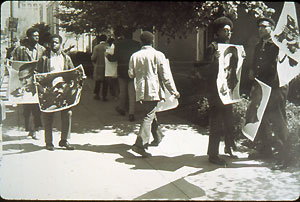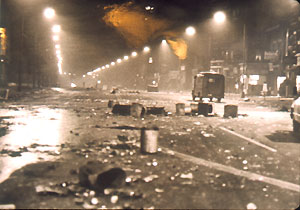The ’60s on film
The Panthers, poverty, and
the peace movement
A Trinity-based collaborative, the Hartford Film Project, with a
consortium of local partners,
produces a feature-length film about a dramatic moment in the
city’s history
by Steve Veshosky
Photographs by Nick Lacy and the Hartford Film Project
“I was downtown eating at a restaurant and a policeman came
in, and another white asked him what he was doing with his dogs.
He said, ‘I’ve got the best nigger chasers going.’ Now that makes
me want to throw a brick and I’m a college-educated, intelligent
black. That makes me want to throw a brick. There’s only so much
people can take.”
Jim Rogers, during a community meeting following
civil disturbances in Hartford during the summer of 1969.
These words represent feelings expressed by many city
residents during a meeting in Hartford’s North End, organized by
the Black Panthers in the summer of 1969.
| |
 |
| |
Hartford Collection.
Hartford Public Library |
That community gathering, called to address rioting and looting
in the city and the police department’s subsequent response, was
captured on film as part of an effort to improve communication
among elements of the racially and economically divided city.
Today, the Trinity-based Hartford Studies Project (HSP), in
collaboration with a consortium of local partners, is producing a
feature-length film that includes pieces of that original footage,
thanks in part to a $100,000 grant from the Rockefeller
Foundation’s Partnerships Affirming Community Transformation
program. Nearly $120,000 in additional funding is being provided
over the next three years by the College; Motion, Inc., an
award-winning local film production company that has supplied a
great deal of in-kind service to the project; funds from the
Kellogg Foundation that are being administered by Trinity; and
from monies dispersed through the dean of faculty’s office.
Hartford 1969/2004: A Community Documentary Film Project, which
will include footage from the 1960s as well as audience reactions
and interviews conducted between 2000 and 2004, will focus on
community organizing activities in Hartford’s neighborhoods and
schools in the era of the civil rights movement and the war in
Southeast Asia. The original footage, intended as a series of
short documentaries for use in public policy advocacy, was filmed
in the city during the summer of 1969 by filmmakers from the
National Film Board of Canada and UCLA, working with local Black
Panthers, community activists, and other Hartford residents.
The 1969 project utilized a technique known as the Fogo method,
named for a fishing community in Newfoundland where Canadian
filmmakers, sent by their government, helped reconcile feuding
members of the island village by allowing each side to see and
hear the other side on film—the result was a successful fishing
cooperative created to avert certain economic disaster. Because
Hartford was particularly torn by the disparities between wealth
and poverty in the late ’60s, it was hoped that the Fogo method
could help Connecticut’s capital city bridge deep racial and
socioeconomic divisions. The Fogo team, including prominent
Canadian filmmaker and Oscar-nominee Julian Biggs, arrived in
Hartford with government funding supplied by the U.S. Office of
Economic Opportunity. For a variety of reasons that included a
change in political leadership in Washington following the 1968
elections, budgetary concerns, and the failing health of Biggs,
the 1969 footage was never released for its intended purpose.
As the members of the crew went their separate ways at the end
of 11 weeks of filming, they gave 13 canisters of footage to
Charles “Butch” Lewis, a decorated Vietnam veteran and founder of
the Hartford chapter of the Black Panther Party. Under Lewis’s
leadership, the Hartford Panthers had established a free breakfast
program for school children, as well as a “street academy” that
offered alternative educational programs to high school students
struggling in public schools. Lewis had been an integral part of
the original film crew—guiding crew members to appropriate
locations for filming, arranging Panther protection, and, at
times, operating a camera. Passionate about his community
involvement as well as the future of Hartford, Lewis was convinced
that, at some point, the film would be valuable. “I knew that what
we had done up to that point was good,” Lewis remembers. “We just
weren’t able to finish it. It was important work, but the filming
just stopped all of a sudden.”
For more than 30 years, the bulk of the film sat, cool and dry,
in a locker in Lewis’s basement. In 1999, following an
announcement that an exhibit of news photographs was being
sponsored by the Hartford collection of the Hartford Public
Library, the Hartford Courant, and the Hartford Studies Project,
Lewis’s wife, Virginia, urged him to contact the Hartford Studies
Project. Associate Professor of History Susan Pennybacker and her
colleagues were stunned and amazed by what they saw on the film.
They immediately recognized the footage as a way to continue,
albeit more than three decades later, a community-wide
conversation about equality and social justice in Hartford.
Additional footage was later located in a California storage
facility and in the National Archives in Washington, D.C.
“The first Trinity people to see the footage, in the spring of
2000, were our student, Steve McFarland, [Associate Professor of
Fine Arts] Pablo Delano, [Associate Professor of History] Luis
Figueroa, [Professor of Sociology] Steve Valocchi, and I. We were
overwhelmed both by the images and by the passion of the
testimony,” explains Pennybacker. “It brought back graphic
memories of my own activities in the Midwest in 1969 as well as my
commitment to social progress, and of the innocence, earnestness,
and importance of local activism in the ’60s.”
| |
 |
| |
Hartford Collection.
Hartford Public Library |
The Hartford Studies Project was established in 1990 by Trinity
faculty members and alumni/ae in an effort to preserve and study
Hartford’s post-Civil War history. Trinity faculty members
involved with the project include Figueroa, Delano, Valocchi,
Associate Director of the Leonard E. Greenberg Center for the
Study of Religion in Public Life Andrew Walsh, Visiting Assistant
Professor of American Studies and HSP Coordinator Elizabeth Rose,
and Visiting Lecturer in American Studies Frank Mitchell.
McFarland ’00, who received a master’s degree in urban planning
from Cornell University last spring, serves as an assistant on the
film project, as does current Trinity graduate student Diane
Smith.
| |
The 1969 project utilized a technique
known as the Fogo method, named for a fishing community in
Newfoundland where Canadian filmmakers, sent by their
government, helped reconcile feuding members of the island
village by allowing each side to see and hear the other side
on film-the result was a successful fishing cooperative
created to avert certain economic disaster. Because Hartford
was particularly torn by the disparities between wealth and
poverty in the late '60s, it was hoped that the Fogo method
could help Connecticut's capital city bridge deep racial and
socioeconomic divisions.
|
The HSP’s methodology is interdisciplinary and unconventional,
bringing together community residents, activists, and academics
through its sponsorship of public programs, photographic
exhibitions, and collaborative research. Through its focus on
issues pertaining to race, immigration, social policy, and local
politics, it seeks to illuminate Hartford’s present through a
better understanding of its past. HSP is partnering with a number
of area organizations on the documentary film project, including
All Our Children, the Community Renewal Team (CRT), the Hartford
Public Library, the NAACP of Greater Hartford, Shiloh Baptist
Church, South Arsenal Neighborhood Development Corporation, Walk
in the Light Ministries, La Voz, and Broad-Park Development
Corporation, Inc.
“We originally got involved with the Hartford Studies Project
because we were making a short film to celebrate our 40th
anniversary,” says CRT spokesperson Liz Dupont-Diehl. “CRT was
founded in 1963 as part of the War on Poverty, and some of the
people who appeared in the original footage have been associated
with our programs. The Trinity folks were fantastic about working
with us and allowing us to use their archival footage. The
Hartford Studies Project and Motion, Inc. helped us produce our
film and we have benefited greatly from our partnership.
Essentially, the partnership allowed us to accomplish a lot more
than we would have been able to accomplish on our own.”
Working with Motion, Inc., HSP is accumulating new footage to
complement the old. There have been several public screenings
featuring various portions of the recovered film, including
gatherings of many of the people who appeared in the original
footage as well as their contemporaries, families, and friends.
HSP members and Trinity students have then interviewed those who
wished to speak on camera. The collected stories, which include
those of young and old, black, white, and Latino, as well as
community activists and politicians, are helping piece together
the thoughts and emotions that played such a vital role in the
events of 1969 and the surrounding era.
“There seem to be a sentimentalization and a popular rendition
of the ’60s that revolve around the iconic figures of the civil
rights movement,” Pennybacker says. “Local complexities and
ambiguities are largely left out of the conversation because
actual testimony, both oral and visual, is absent. For example,
the significant Latino presence of that time is rarely mentioned
or celebrated. The authenticity of this material makes it part of
a set of valuable historical documents, and the testimony and
images that we are currently taking and filming are equally
valuable as commentary on contemporary Hartford.”
Captured among the dozens of hours of original footage are the
city’s first Puerto Rican parade and a community meeting during
which North End mothers of small children relate instances of
police officers firing canisters of tear gas into their homes. The
film crew also recorded interviews and committee meetings
featuring local government and business leaders, lawyers,
teachers, and neighborhood residents. Included in the footage are
black activists, Puerto Rican civic leaders, white politicians,
students protesting racism in local schools, concerned parents,
and the organizers of a community food cooperative. Many residents
of Hartford became involved in the film project that summer, and
the films were centered around the broad theme of their daily
struggles and their hopes and dreams for the future.
Pennybacker, who is also the director of the Hartford Studies
Project, serves as the documentary’s producer, while Motion, Inc.
President and Visiting Lecturer in Film Studies Glenn Orkin is
directing. Figueroa is lending technical expertise to the project.
Pennybacker, Lewis, and their HSP colleagues and partners plan to
create from that original footage—along with a host of the more
recently conducted interviews—a film that will remain true to the
spirit of the Fogo method: it will attempt to find common ground
and purpose among communities long separated by race, class, and
socioeconomic status.
“We have a unique opportunity to view the present through
authoritative—not unbiased, but very useful—images of the past, to
critique the present in light of recent history,” she says. “This
is for some urban areas a forgotten art form, and its use here in
Hartford is essential for a clear understanding of the paths and
choices ahead. We dismiss or forget our history at the city’s
peril. The Fogo practitioners thought their film could actually
reduce conflict. I’m not sure about that, but I do think it can
help explain why it happened, why it could continue to happen, and
help us map out some of the decisions that have been made—so that
we, as residents and voters, can make better choices in the
future.”
For further information, go to
www.trincoll.edu/depts/hartstud/.
back to top
|